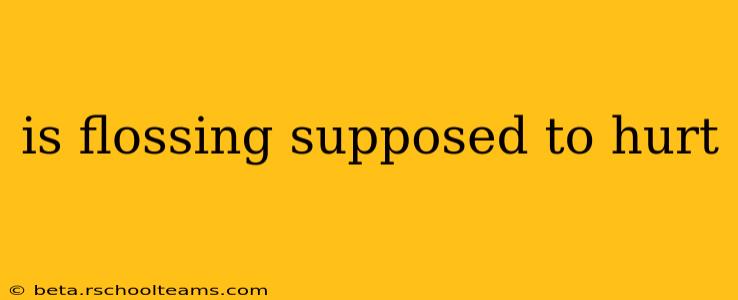Is Flossing Supposed to Hurt? Understanding Floss and Gum Health
Flossing is a crucial part of maintaining good oral hygiene, but the question many people ask is: is flossing supposed to hurt? The short answer is no, flossing shouldn't cause significant pain. A little bit of discomfort is sometimes normal, especially when you're first starting, but persistent pain signals a potential problem. Let's delve deeper into this common concern.
Why Does Flossing Sometimes Hurt?
Several factors can contribute to discomfort when flossing:
- Improper Technique: Using too much force or aggressively snapping the floss between teeth is the most common cause of pain. Gentle, careful movements are key. We'll cover proper technique later in this article.
- Inflamed Gums: If your gums are already inflamed (gingivitis), flossing can be more sensitive. Inflammation is often caused by plaque buildup, which flossing helps to remove. The initial discomfort might actually be a sign that you need to floss more regularly!
- Bleeding Gums: Bleeding gums are often an indication of gingivitis. While a little bleeding might occur initially as you start flossing more regularly, persistent bleeding warrants a visit to the dentist.
- Tight Teeth: Some people naturally have tightly packed teeth, making it slightly more challenging and potentially uncomfortable to floss. Using a thinner floss, such as waxed floss, can help.
- Dental Work: Recent dental work, such as fillings or extractions, may make the area around the teeth more sensitive to flossing. In these cases, it's advisable to contact your dentist for specific advice.
What Should I Do If Flossing Hurts?
If flossing consistently causes pain, don't just push through it. Instead:
- Adjust Your Technique: Focus on gentle movements, curving the floss around each tooth in a "C" shape and avoiding snapping it against the gums.
- Use a Different Type of Floss: Experiment with different types of floss, such as waxed floss, unwaxed floss, or floss picks, to find what works best for you and your teeth.
- Increase Frequency Gradually: If you're new to flossing, start by flossing once a day and gradually increase the frequency as your gums become more accustomed to it.
- See Your Dentist: Persistent pain, bleeding, or other concerns during flossing should always be addressed by a dentist. They can identify the underlying cause and provide guidance on proper flossing techniques.
How Can I Floss Without Hurting Myself?
Proper technique is paramount to comfortable and effective flossing. Here's a step-by-step guide:
- Use about 18 inches of floss. Wind most of it around your middle fingers, leaving about an inch to work with.
- Gently guide the floss between your teeth. Use a back-and-forth motion, avoiding snapping the floss.
- Curve the floss into a "C" shape against each tooth, hugging the curve of the tooth.
- Gently slide the floss up and down along the side of each tooth, reaching below the gum line.
- Use a clean section of floss for each tooth.
Is Flossing Necessary If It Hurts?
Yes! Even if flossing initially causes some discomfort, it's crucial for maintaining good oral health. The benefits of removing plaque and preventing gum disease far outweigh the temporary discomfort. Remember, the goal is to gently remove plaque, not to cause pain. Addressing the underlying cause of the pain (improper technique, gum inflammation, etc.) is key to making flossing a comfortable and beneficial part of your daily routine.
What are some alternatives to traditional floss?
Several alternatives to traditional floss exist, including floss picks, interdental brushes, and water flossers. Each has its own benefits and drawbacks. Your dentist can help you determine the best option for your individual needs.
By following these tips and paying attention to your body's signals, you can make flossing a painless and essential part of your oral hygiene routine. If you're experiencing persistent pain, however, don't hesitate to consult your dentist. They are your best resource for addressing any concerns and ensuring your oral health is in top shape.
